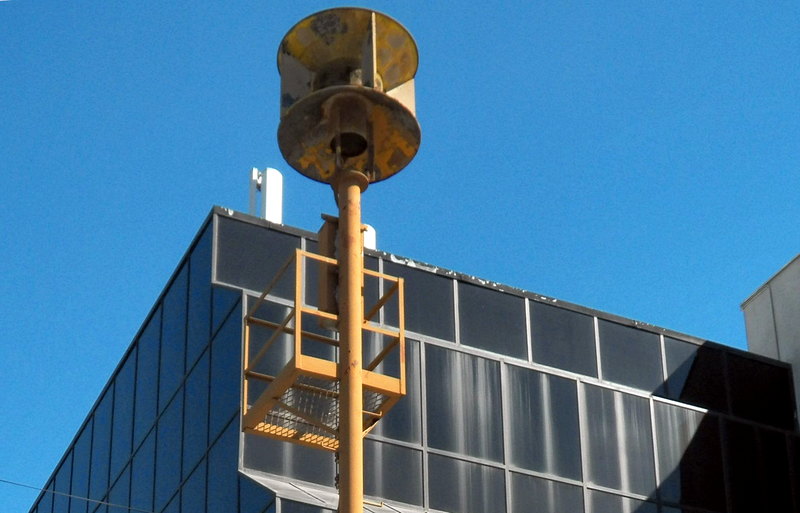Air raid sirens have howled relentlessly over Ukraine’s cities, towns, and villages since the first moments of Russia’s damnable invasion, a sustained buzz that plunges to a bass tone, elongating its Purge-y bleat before rising back into a high cry and looping back.
The dooming whine sends families and seniors scrambling to dank bomb shelters that often haven’t been cracked or cleaned since WWII. If and when they emerge, respite is said to be temporary, the air raid sirens sure to go off again in 30 minutes, forcing everyone to repeat the wartime choreography. Or, like several people we know, stay put in their apartments, sleeping in their bathtubs, ready to face the horrors that come from the ephemeral comfort of home.
With the sound etched in our minds from too much CNN over the last two weeks, we were surprised to learn that Los Angeles has its own preponderance of 20th century air raid sirens. As well as an entire community that is obsessed with them.
It was during World War II and in the ensuing years of the Cold War that the Los Angeles Civil Defense Siren was instituted, typically operated by local government and law enforcement agencies, though produced by private enterprise. At one time, there were over 250 tower-strapped sirens in the city.
Talk with an Angeleno over 60 and you’ll most likely hear stories of these sirens' songs preceding school duck-and-cover drills at 10 AM every Friday morning, prepping them for an A-bomb or Russian incursion that fortunately never came. Today, many of these air raid siren towers still exist among L.A.’s streets, from Calabasas to the San Gabriel Valley. You can go and see them yourself while walking around. Though it helps if you know where to look.
The city’s #1 air raid siren expert is frequently cited as one Dennis Hanley, who, in 2006, mapped out 231 air raid sirens still to be found in just about every L.A. neighborhood, a Rosetta Stone of sorts for L.A.’s active air raid siren-hunting community, which produces YouTube videos and forum posts sussing out where to locate them. Or where they may be suddenly missing.
This is a community that knows whether they’re looking at a Federal 500-SH-TT or a Federal SD-10. Who can differentiate between the early, single-toned Short A Frame Federal Electric Model 5 from the late-stage model powered by a Chrysler Model 20A V8 Hemi engine. It's a brave new—old—world of sirens, folks.
An excellent breakdown of what you may find when doing your own siren-hunting can be found here on Cold War LA, a site that documents our city’s own experiences from that era, including a sobering look into L.A.’s Cold War missile sites.
Of course, as with anything old, beloved, and of seemingly no commercial value to developers in L.A., we have to wonder if they’re disappearing. We turned to ask our preservationist pals Kim Cooper and Richard Schave at Esotouric, who characteristically, did not disappoint.
“[We] have been tracking them from a preservation standpoint,” Cooper tells L.A. TACO. “Because 149 are on the Survey LA list of historic resources, and yet developers have illegally removed and ‘lost’ them, maybe sold for scrap or taken by collectors. This just happened to the one on the back side of the Frank Gehry Grand Avenue project on Bunker Hill.”
Cooper points out how some of the sirens have also been repurposed over the years. One SD-10 siren that was removed for the construction of L.A. Live! was turned into a floral sculpture called Daffodil Metamorphosis in 1996, by artist Michael Tansey then placed on Cherry Street, long viewable from the 110 Freeway. Another siren was employed in an aural art installation called Seirá by Brisbane-based composer and curator Lawrence English, which sounded tones across various parts of L.A. every evening over nine days in November, 2018.
Although nuclear war is still, too much a conceivable threat to Los Angeles in 2022, the sirens apparently no longer work. Nor is it really known who would work them anyway. In a sign of our digital times, we’d most likely be informed of an impending bomb strike in the same way we’re updated about missing seniors and kidnapped kinderfolk heading south in someone’s green Hyundai. That is, via smartphone alerts. Much like those poor souls in Hawaii who were falsely alerted that a ballistic missile was inbound in 2018, spreading 38 minutes of pure panic.
In case your dark curiosity takes you there, a nuclear missile fired from Russia is hypothesized to take about 30 minutes to arrive to the U.S. (and 15 minutes if fired by a submarine), according to The Union of Concerned Scientists. The bigger question may not be whether there’s an alert system that works for Los Angeles, but where the hell we all go if so.







